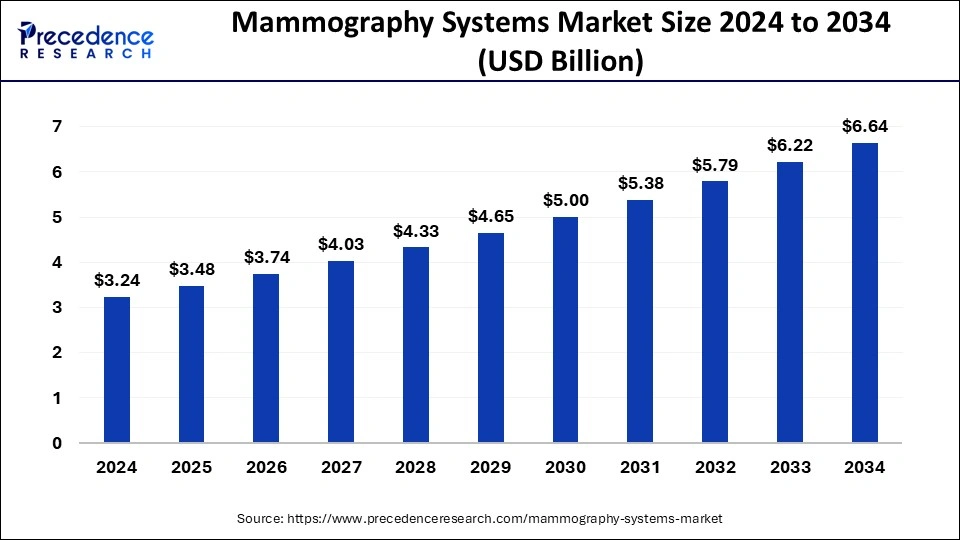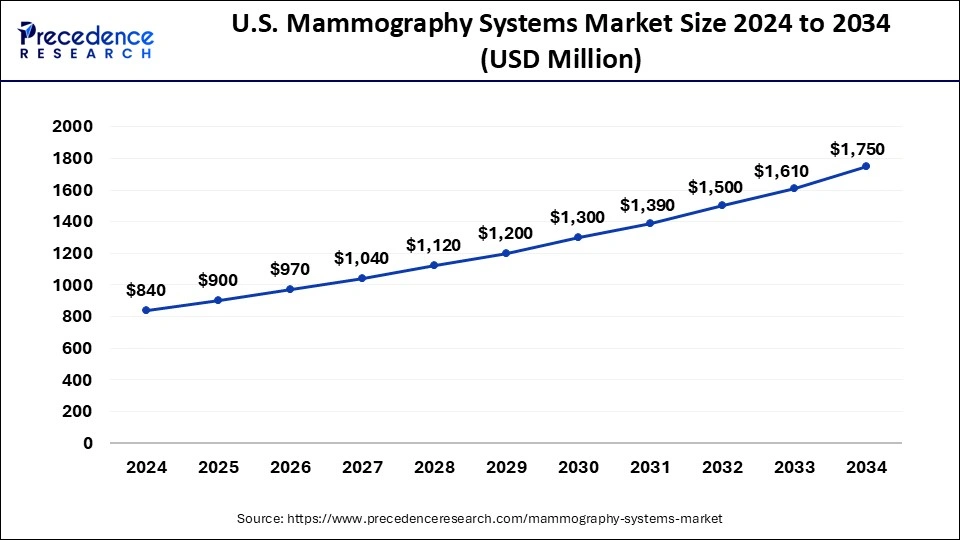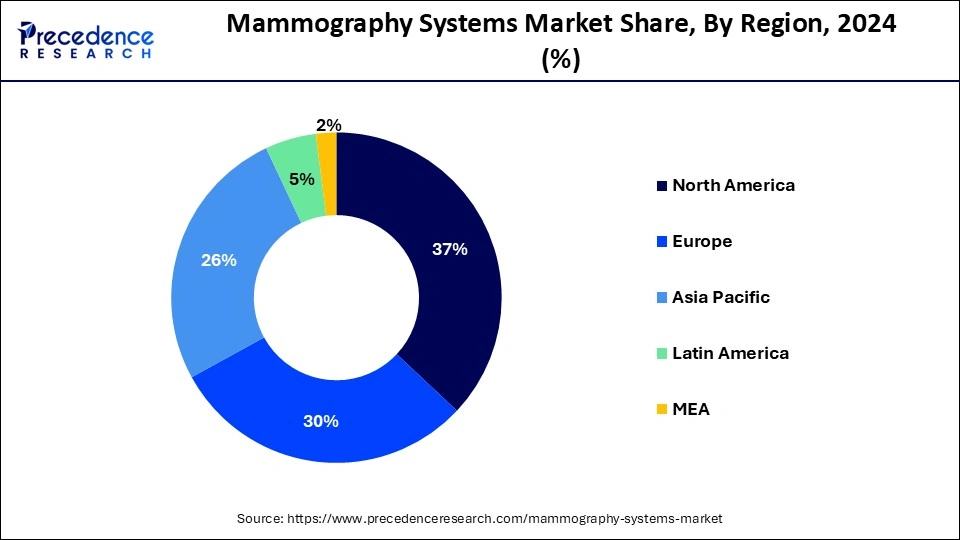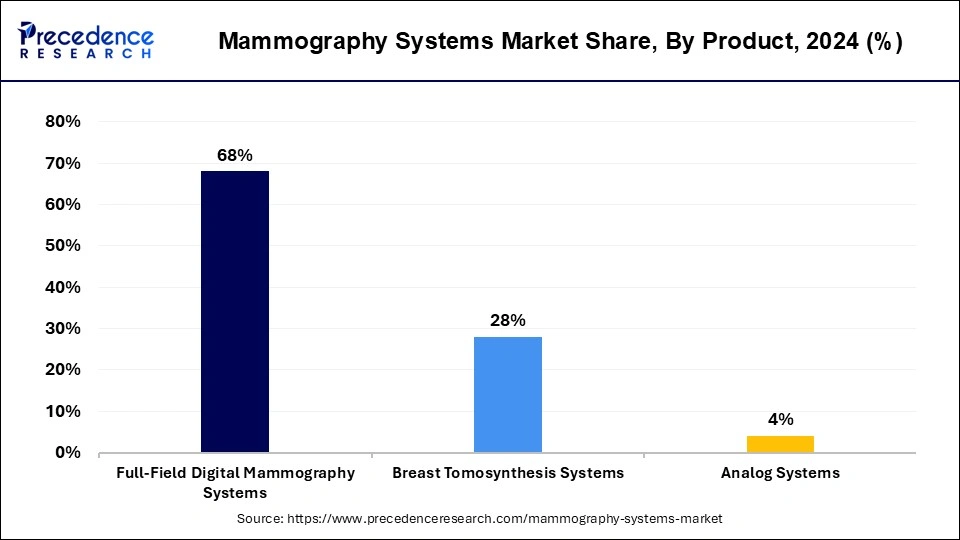December 2024
The global mammography systems market size accounted for USD 3.48 billion in 2025 and is forecasted to hit around USD 6.64 billion by 2034, representing a CAGR of 7.44% from 2025 to 2034. The North America market size was estimated at USD 1.20 billion in 2024 and is expanding at a CAGR of 7.57% during the forecast period. The market sizing and forecasts are revenue-based (USD Million/Billion), with 2024 as the base year.
The global mammography systems market size accounted for USD 3.24 billion in 2024 and is predicted to increase from USD 3.48 billion in 2025 to approximately USD 6.64 billion by 2034, expanding at a CAGR of 7.44% from 2025 to 2034. Due to the growing incidence of breast diseases such as cancer in women, there is a significant concern for detecting those diseases in their early stages and curing them with proper treatment. Mammography systems have significantly helped medical agencies to minimize the burden of breast cancer across the world.

The U.S. mammography systems market size was exhibited at USD 840 million in 2024 and is projected to be worth around USD 1,750 million by 2034, growing at a CAGR of 7.62%.

North America held the largest market share of 37% in 2024, and globally, owing to the growing prevalence of breast cancer, with a significant market share in the forecasted period. The reason behind the growth in the region is the presence of major key players in the market and the concerned population for early detection and diagnosis of the disease to limit the mortality rate. Also, various favorable initiatives by various organizations uplift the market growth of the market.

Asia Pacific, the mammography systems market is expected to experience the fastest growth, with a significant CAGR over the forecast period. This is mainly due to the development of countries such as China, India, and Japan. The increased prevalence of breast cancer, high investments in research and development for breast cancer therapies, and advancements in breast imaging modalities are the primary drivers that are propelling the market growth in Asia-Pacific.
Breast cancer has become a global cause of concern because of the increase in cases worldwide. It is one of the most prevalent cancers affecting both men and women, but mainly dominates women. Digital mammography, or X-ray imaging of the breast, is the most common method to screen for breast cancer. The mammography systems market provides specialized medical imaging that employs a low-radiation X-ray to observe the internal structure of the breasts and check abnormalities without any symptoms, which helps physicians analyze and treat medical conditions. Digital mammography is used in a wide variety of settings, including hospitals, specialist clinics, and diagnostic and ambulatory surgery centers.
Breast cancer screening systems are becoming more widespread, and the government is taking steps to support clinical interpretation. These are key factors expected to drive the growth of the market. There are various mammography solutions available, including breast tomosynthesis, film screen systems, and X-rays for the detection of breast cancer. However, 3D mammography has become the gold standard for detecting breast cancer due to advancements in technology. The growth in the mammography systems market is propelled by all these factors and advanced technologies because of the high demand in the market.
| Report Coverage | Details |
| Growth Rate from 2025 to 2034 | CAGR of 7.44% |
| Market Size in 2025 | USD 3.48 Billion |
| Market Size by 2034 | USD 6.64 Billion |
| Base Year | 2024 |
| Forecast Period | 2025 to 2034 |
| Segments Covered | Product, Technology, and End-user |
| Regions Covered | North America, Europe, Asia-Pacific, Latin America, and Middle East & Africa |
Rise in cases of breast cancer worldwide
Breast cancer stands as the second most common cancer globally, with around 2.3 million new cases, accounting for approximately 11% of total new cancer cases. This makes early detection crucial for effective treatment and higher chances of survival. Women's growing awareness about breast cancer, its diagnosis, and treatment is likely to boost sales in the mammography systems market.
Advanced screening tools
Advanced screen tools for breast cancer are crucial in detecting the disease in the early stage and can be treated. Regular mammograms are one of the most effective screening tools for detecting breast cancer. Also, full-field digital mammograms and 3D mammography have significantly improved breast cancer detection techniques with fewer false positive results. It also provides more detailed images of breast tissue and helps to detect smaller breast cancers. Adopting these technologies meets the growing demand for breast cancer detection and uplifts the mammography systems market.
Lack of knowledge and awareness regarding mammography systems
The absence of knowledge about mammography frameworks persists regardless of the developing prominence of mammography for the identification of breast cancer disease; different difficulties are generally limiting business developments in the mammography systems market. These variables include exposure to radiation, high capital venture, and lack of awareness about mammography systems across a few developing and underdeveloped regions worldwide.
Initiatives and investments by the government and private organizations for breast cancer
Breast cancer is the primary or second leading cause of cancer deaths in women in 95% of countries. However, survival rates for breast cancer vary greatly both between and within countries. Lower and middle-income people in countries account for almost 80% of breast and cervical cancer deaths. Weaker health system regions are least able to cope with the increasing burden of breast cancer. To this end, there are various organizations involved and putting their efforts into diagnosing and treating breast cancer. Therefore, mammography technology is highly adopted in healthcare services.
The full-field digital mammography systems segment held the largest market share of 68% in 2024. It is considered the most prominent way of detecting cancer at an early stage and provides better image resolution than other systems. The results obtained can ensure more accurate detection of breast cancer.

The breast tomosynthesis systems segment is the fastest-growing and is expected to uplift the growth of the mammography systems market in the forecasted period. This growth is primarily attributed to the accuracy of diagnosis associated with the breast tomosynthesis systems. Radiologists often employ this cutting-edge technique in cases involving dense body tissue. Its efficiency in diagnostic, as well as screening procedures, has attracted the interest of several market players, opening opportunities for collaborations and other ventures.
The 3D mammography systems segment is projected to be the fastest growing and is expected to increase CAGR in the forecasted period. A 3D mammogram is an imaging test that creates a three-dimensional breast image. It is used to look for breast cancer in people with the absence of any signs or symptoms. Also, it can help to investigate the cause of different breast problems, for example, breast mass, pain, and discharge from the nipples. 2D mammography systems are not successful in identifying every indication of cancer, so further advancements are needed for the identification of the disease.
The hospitals segment led the mammography systems market in 2024. Hospitals typically handle a large volume of patients, including those seeking preventive screenings, diagnostic tests, and treatment for various medical conditions. Mammography, as a crucial tool for breast cancer detection and screening, is frequently performed in hospital settings due to their capacity to accommodate a high number of patients efficiently. Hospitals often invest in state-of-the-art medical equipment and imaging technology to provide accurate and reliable diagnostic services. Mammography systems installed in hospitals are typically equipped with advanced features such as digital imaging, 3D mammography (tomosynthesis), and computer-aided detection (CAD), enhancing the accuracy and efficiency of breast cancer detection.
The ambulatory surgical centers segment is projected to uplift the market in the upcoming years. These centers consist of advanced cancer detection devices, further improving the diagnosis procedures. Safe, effective, and less time-consuming procedures are also expected to uplift mammography systems in such centers for detecting cancer. Ambulatory surgical centers offer convenient and accessible healthcare services, including mammography screenings, to patients in a community-based setting. Patients can undergo mammograms at ASCs without the need for hospital admission, reducing wait times and offering greater flexibility in scheduling appointments. This convenience encourages more individuals to undergo regular mammography screenings, leading to higher demand for mammography systems in ASCs.
By Product
By Technology
By End-user
By Geography
For inquiries regarding discounts, bulk purchases, or customization requests, please contact us at sales@precedenceresearch.com
No cookie-cutter, only authentic analysis – take the 1st step to become a Precedence Research client
December 2024
July 2024
January 2025
January 2025